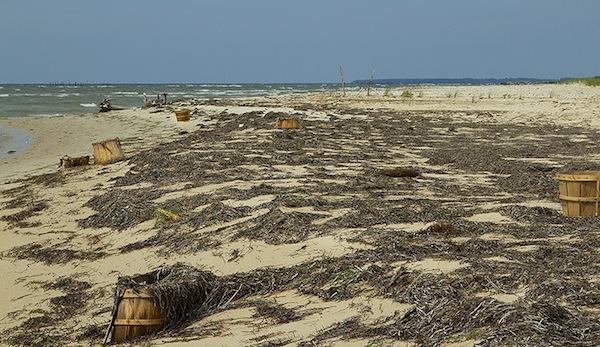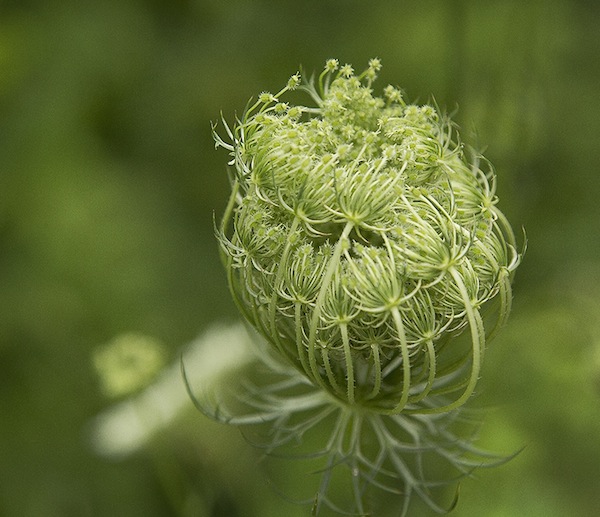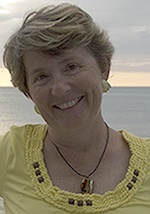SHER: On the Shore Eight Weeks

Photo by Sher Horosko
By SHER HOROSKO
Cape Charles Wave
July 31, 2013
The road to Custis Tomb is lined with snowflakes perched on arching green stems. I capture the beauty-burst and the swaying flowers filled with winged ones I cannot name.
Then comes the inevitable fading. Crocheted saucers fold into urns. Their time here is nearly done.
I have been on the Shore eight weeks. It is my spirit to watch closely, to be curious and to mark the comings and goings of life:
—the wheat fields trimmed and seeded with soybeans, tinkered with to withstand this concoction or that;
—the winged and petaled ones birthing and blooming and moving on or folding back into the sandy earth;
—how guts are transformed from expansive ripples of water where all may pass to bright white stakes marking territories like fences in the land-bound world.
I notice these things. They are subtle. The disappearance of what one loves happens slowly.
We get used to Beauty, fading, much like the lines streaking across our cheeks. Only when we see a photograph of what we looked like ten years ago, or even five, do we realize what is becoming of us: our bodies, our skin, our hair whiter and whiter.
CONTINUED FROM FIRST PAGE
Here we are. This is us: our costume is falling away like the snowflakes turning to urns. Were it not for the photographs of what once was, we might not even notice at all.
It is the same with the land and sea. The disappearances are a daily event. “The land and sea are constantly changing,” a born-here said to me.
But there are changes like the lines on my face and yours and there are changes that siphon the blood from a place.
You know the difference. So do I.
Outside my window, no plant grows, not clover or wild mustard or Queen Anne’s Lace, nothing; nothing at all except green corridors of soybeans. The cabbage white butterflies with their tiny black dots have shuttered their wings and disappeared and the iridescent dragonflies are gone.
Except for the soybeans, everything is dying or dead. Slowly, we get used to this, ignore it, or even make sense of it.
Standing in the field near the Custis graves, I peer through window-breaks in the tree line at the gulls soaring and plunging over Old Plantation Creek. Is it the wind rustling the grasses and saucer-sized flowers I hear? Or is it centuries of whispering from all the disappeared speaking at once: The Algonquins, the Angolans and their African neighbors; the deer, the herons and the long black snakes . . . .
What you read about, what I read about, is mostly the stories of those who have gathered great stretches of land and even expanses of sea. We hear about those whose names are etched in marble and whose bloodlines span oceans half a world a way. A friend of mine here suggested I write about the history of this land. I said nothing.
“Whose history?”
Like Charles Dickens, what interests me is what people do with what they have, whether they give the Cratchits a Christmas turkey and help little Tim with his crutches. What interests me is what people give to the land and sea, how they love it, whether they see it as part of their hearts and skin.
Or whether they mostly take or fence or guard or plunder (albeit in sweet-toned ways). Eight weeks.
A land and sea that pulls your heart into your throat, that stirs you, that says: “Show me how you love me.”
A land of too many fences and unnatural deaths, where the spent baskets of a crab waterman are strewn over the whole coast of Savage Neck, a land where plastic nets once filled with clams are left in the sands like sunken ships from another time.
It will take a thousand years for them to dissolve, if then.
This is a land of rich ordinary lives, many struggling hard. They cook chicken dinners in Cheriton and pull people from burning buildings, run food pantries in church basements and shuttle tiny children on buses when the dawn breaks so their parents can harvest tomatoes in our fields.
There are stories (I’ve heard some of them) that could break a world, open.
Yesterday, someone said to me: “I don’t notice these things. I have been here too long.”
But maybe you can try to notice. Maybe you can sharpen your eyes just a little, rub them awake and notice who gives the turkey and the crutches.
To the Cratchits.
To the land.
To the sea close by.
And maybe, just maybe, you can join them — lest that which you love, disappears.

Photo by Sher Horosko
 Sher Horosko’s commentary is an occasional Wednesday feature of the Wave. A recent transplant to the Eastern Shore, Sher writes on nature and spirituality at sherhoroskoblogdotcom.wordpress.com.
Sher Horosko’s commentary is an occasional Wednesday feature of the Wave. A recent transplant to the Eastern Shore, Sher writes on nature and spirituality at sherhoroskoblogdotcom.wordpress.com.




















Sher is a great writer. She also shows the wisdom gained by age in trade for that of youth and beauty. A good asset for your enterprise.
Thanks for bearing witness and opening our eyes once again to the beauty and fragility of life — and reminding us that ultimately we are the caretakers and cultivators of the life around us.